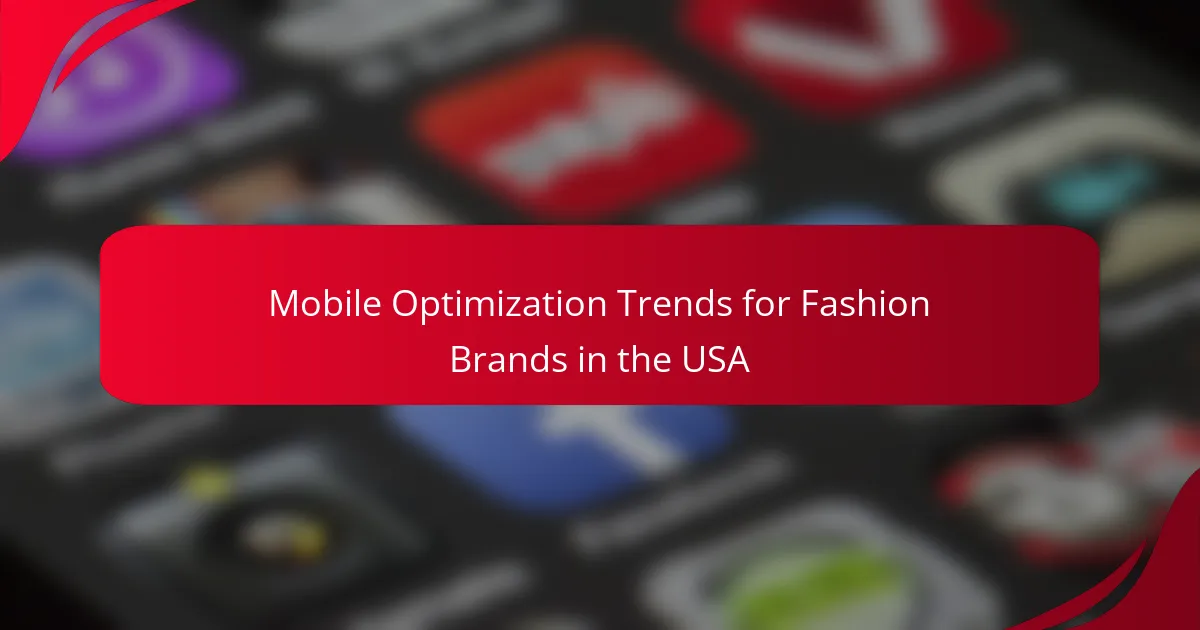For fashion brands in the United States, implementing a robust SEO checklist is crucial for enhancing online visibility and attracting the right audience. Key strategies include optimizing for relevant keywords, ensuring mobile-friendly designs, and creating high-quality visual content. By focusing on these elements, brands can improve their search engine rankings and drive organic traffic effectively.

What are the essential SEO strategies for fashion brands in the United States?
Essential SEO strategies for fashion brands in the United States include optimizing for relevant keywords, ensuring mobile-friendly designs, creating high-quality visual content, implementing local SEO practices, and integrating social media effectively. These strategies help improve visibility in search engines and attract targeted customers.
Keyword optimization for fashion terms
Keyword optimization involves researching and selecting the right fashion-related terms that potential customers use when searching online. Focus on long-tail keywords, such as “sustainable women’s shoes” or “affordable summer dresses,” which can drive more targeted traffic.
Utilize tools like Google Keyword Planner or SEMrush to identify popular search terms and analyze competition. Incorporate these keywords naturally into product descriptions, blog posts, and meta tags to enhance search engine rankings.
Mobile-friendly website design
A mobile-friendly website design is crucial as a significant portion of online shopping occurs on mobile devices. Ensure your site is responsive, meaning it adjusts seamlessly to different screen sizes, providing an optimal user experience.
Consider using large, readable fonts and easy navigation to enhance usability. Google prioritizes mobile-friendly sites in its rankings, so testing your website with tools like Google’s Mobile-Friendly Test can help identify areas for improvement.
High-quality visual content
High-quality visual content is vital for fashion brands, as customers rely heavily on images to make purchasing decisions. Use professional photography and ensure images are optimized for fast loading without sacrificing quality.
Incorporate various formats, such as videos and 360-degree views, to engage users. Descriptive alt text for images not only improves accessibility but also aids in SEO by providing context for search engines.
Local SEO for fashion retailers
Local SEO strategies help fashion retailers attract nearby customers. Start by claiming your Google My Business listing and ensuring that your name, address, and phone number (NAP) are consistent across all online platforms.
Encourage satisfied customers to leave reviews, as positive feedback can enhance your local search visibility. Additionally, consider optimizing your website for local keywords, such as “boutique in [City Name],” to attract local shoppers.
Social media integration
Integrating social media into your SEO strategy can significantly boost brand visibility and engagement. Use platforms like Instagram and Pinterest, which are visually driven, to showcase your fashion products and connect with your audience.
Share user-generated content and collaborate with influencers to expand your reach. Ensure that your social media profiles link back to your website, driving traffic and improving your overall SEO performance.

How can fashion brands improve their website performance?
Fashion brands can enhance their website performance by focusing on page speed, optimizing images, and implementing responsive design. These factors significantly impact user experience, search engine rankings, and ultimately, conversion rates.
Page speed optimization techniques
To optimize page speed, fashion brands should aim for loading times under three seconds. Techniques include minimizing HTTP requests, leveraging browser caching, and using content delivery networks (CDNs) to distribute content efficiently. Regularly testing page speed with tools like Google PageSpeed Insights can help identify areas for improvement.
Brands should also consider reducing the size of CSS and JavaScript files through minification and combining multiple files into one. This reduces the overall load time and enhances user experience.
Image compression tools
Images are crucial for fashion websites but can slow down loading times if not optimized. Using image compression tools like TinyPNG or ImageOptim can significantly reduce file sizes without sacrificing quality. Aim for a balance where images maintain visual appeal while being lightweight.
Consider using the WebP format, which offers superior compression compared to traditional formats like JPEG and PNG. This can lead to faster load times and improved performance on various devices.
Responsive design frameworks
Responsive design ensures that a fashion brand’s website performs well on all devices, from desktops to smartphones. Frameworks like Bootstrap or Foundation provide pre-built components that adapt to different screen sizes, enhancing usability and accessibility.
When implementing responsive design, prioritize mobile-first strategies, as a significant portion of users shop via mobile devices. Testing across various devices and screen sizes is essential to ensure a seamless experience for all visitors.

What role does content marketing play in fashion SEO?
Content marketing is essential for fashion SEO as it enhances brand visibility, engages customers, and drives organic traffic. By creating valuable and relevant content, fashion brands can improve their search engine rankings and connect with their target audience effectively.
Blogging about fashion trends
Blogging about fashion trends allows brands to showcase their expertise and attract potential customers. Regularly updated blogs can improve SEO by incorporating relevant keywords and phrases that consumers are searching for. Aim to post at least once a week to keep content fresh and engaging.
Consider including seasonal trends, style guides, and outfit inspirations in your blog posts. This not only provides value to readers but also encourages sharing on social media, further boosting your brand’s visibility.
Influencer collaborations
Collaborating with influencers can significantly enhance a fashion brand’s reach and credibility. Influencers often have dedicated followings, and their endorsements can lead to increased traffic and sales. Choose influencers whose style aligns with your brand to ensure authenticity.
When planning a collaboration, consider creating unique discount codes or special promotions for the influencer’s audience. This not only incentivizes purchases but also helps track the effectiveness of the partnership.
Video marketing strategies
Video marketing is a powerful tool for fashion brands, as it allows for dynamic storytelling and product showcasing. Platforms like Instagram and TikTok are particularly effective for fashion videos, where short, engaging content can capture attention quickly. Aim for videos that are under a minute for optimal engagement.
Consider creating lookbooks, behind-the-scenes content, or styling tips to connect with your audience. Ensure that your videos are optimized for SEO by including relevant keywords in titles and descriptions, and use engaging thumbnails to increase click-through rates.

What are the best tools for SEO analysis in the fashion industry?
For fashion brands in the United States, effective SEO analysis tools can significantly enhance online visibility and traffic. Key tools like Google Analytics, SEMrush, and Ahrefs provide valuable insights into website performance, keyword opportunities, and backlink profiles.
Google Analytics for tracking
Google Analytics is essential for tracking website performance and user behavior. It allows fashion brands to monitor traffic sources, user demographics, and engagement metrics, helping to identify which marketing strategies are most effective.
To get started, set up goals that align with your business objectives, such as sales conversions or newsletter sign-ups. Regularly review reports to adjust your SEO strategies based on user interactions and trends.
SEMrush for keyword research
SEMrush is a powerful tool for keyword research, enabling fashion brands to discover high-traffic keywords relevant to their niche. It provides insights into search volume, keyword difficulty, and competitor strategies, which can inform content creation and optimization efforts.
Utilize the Keyword Magic Tool to generate a list of potential keywords, focusing on long-tail variations that reflect user intent. Regularly update your keyword strategy based on seasonal trends and emerging fashion topics.
Ahrefs for backlink analysis
Ahrefs is invaluable for analyzing backlinks, which are crucial for improving domain authority and search rankings. It allows fashion brands to assess their backlink profile and identify opportunities for acquiring high-quality links from reputable sources.
Use the Site Explorer feature to review your website’s backlinks and those of competitors. Focus on gaining links from fashion blogs, influencers, and industry publications to enhance credibility and visibility in search results.

How do fashion brands leverage social media for SEO?
Fashion brands utilize social media to enhance their SEO by increasing brand visibility, driving traffic to their websites, and improving engagement. By strategically using platforms like Instagram, Pinterest, and Facebook, brands can create content that resonates with their audience and boosts their search engine rankings.
Instagram for visual storytelling
Instagram is a powerful platform for fashion brands to tell their stories visually, showcasing products through high-quality images and videos. Brands can use features like Stories and Reels to engage users and encourage shares, which can lead to increased website traffic and improved SEO performance.
To maximize impact, brands should maintain a consistent aesthetic and use relevant hashtags to reach their target audience. Engaging with followers through comments and direct messages can also foster community and loyalty, further enhancing brand presence online.
Pinterest for driving traffic
Pinterest serves as a visual search engine, making it an ideal platform for fashion brands to drive traffic to their websites. By creating eye-catching pins that link back to product pages or blog posts, brands can attract users who are actively seeking fashion inspiration and ideas.
Brands should focus on optimizing their pins with keywords in descriptions and using vertical images for better visibility. Regularly updating boards and engaging with trends can also help maintain relevance and attract more visitors.
Facebook for community engagement
Facebook allows fashion brands to build a community around their products, fostering engagement through posts, groups, and events. By sharing content that resonates with their audience, brands can encourage discussions and interactions that enhance brand loyalty and visibility.
To effectively use Facebook, brands should post regularly, utilize Facebook Live for product launches or Q&A sessions, and encourage user-generated content. This not only strengthens community ties but also boosts organic reach, which can positively impact SEO efforts.










